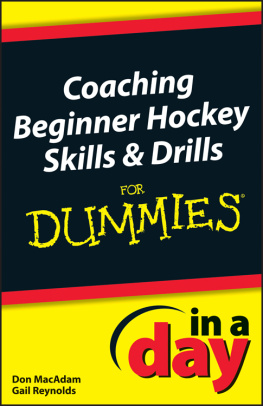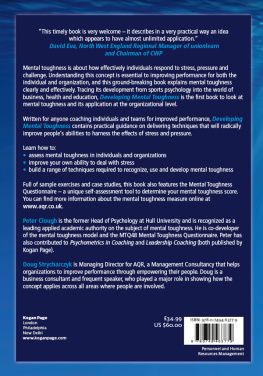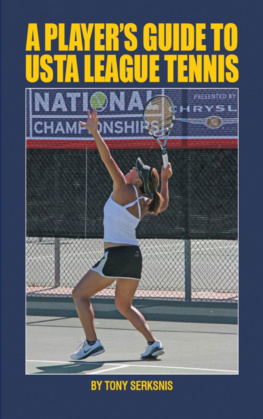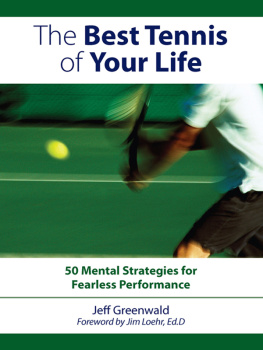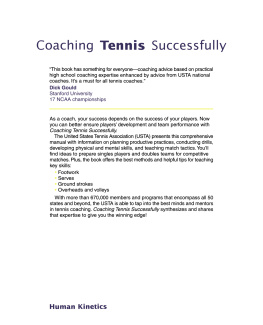
USTA
Mental Skills
and
Drills Handbook
Editedby Larry Lauer, Daniel Gould, Paul Lubbers, and Mark Kovacs

2010 Coaches Choice. All rights reserved. Printed in the United States.
No part of this book may be reproduced, stored in a retrieval system, or transmitted, in any form or by any means, electronic, mechanical, photocopying, recording, or otherwise, without the prior permission of Coaches Choice. Throughout this book, the masculine shall be deemed to include the feminine and vice versa.
ISBN: 978-1-60679-080-9
Library of Congress Control Number: 2009943112 Cover design: Brenden Murphy
Book layout: Studio J Art & Design
Front cover photo: 2008 Getty Images
Back cover photo of Paul Lubbers: Robert Nolan
Coaches Choice
P.O. Box 1828
Monterey, CA 93942
www.coacheschoice.com

This book and the project from which it evolved would not have been possible without the assistance of many individuals. First and foremost, we are indebted to the United States Tennis Association (USTA) Sport Science Committee and the USA Tennis Player Development Division for funding the project and providing much of the logistical support needed to make it successful. In particular, we would like to recognize the assistance of Dr. Paul Lubbers and Dr. Paul Roetert in this regard. Additional support for the project was provided by the University of North Carolina at Greensboro (UNCG) Department of Exercise and Sport Science and more recently from the Institute for the Study or Youth Sports and Department of Kinesiology at Michigan State University.
The authors are also indebted to many former members of the UNCG Applied Sport Psychology Research Laboratory for helping in the review of the mental training in tennis literature. These individuals are, in no particular order, Betsy Smith, Dr. Nicole Damarjian, and Dr. Marc Strickland. Kristine Johnson, Missy Wright, and Jennifer Thomas were also invaluable in helping us with the editing of the book.
Finally, we want to thank all of the coaches for volunteering their time and expertise to take part in the focus group and survey portions of the research project. Numerous athletes also allowed us to field test the skills and drills with them, and the editors are especially appreciative of the participants who provided feedback on the mental-training exercises in USA Tennis High Performance Coaching Programs conducted over a five-year period. These opportunities allowed us to present the skills and drills to players and coaches who were kind enough to provide valuable feedback about the utility of the skills and drills developed.

The USTA Mental Skills and Drills Handbook shows that success in tennis requires the complete package physical, mental, and emotional skill, knowledge, and heart. It also is a good reminder to coaches and parents that good players reach their full potential because they understand how to get the most of their physical abilities while maximizing the mental and emotional side of the sport.
Even though I am or more years removed from my competitive playing career, I still use things I learned on a tennis court in my life today. Everything I learned in sports, from handling pressure to managing commitments and responsibilities, I try to incorporate in my daily life. That is one of the great things about tennis. Not only is it a great life sport physically, it teaches life lessons.
If players have paid the price and done the work physically and have proper technique, they will become stronger mentally. The two parts of the game are definitely integrated. The mental side of sports is what sets and raises the bar. As players improve their ability to manage the mental side of things, the other parts of their game also start the trend upward. Improvement of players mental approach can often bring about enhancements in the physical parts of their gamethey become more confident on and off the court and situations that were previously difficult for them seem easier.
If players have a pyramid of physical, mental, and emotional, the emotional part has always been at the top of the pyramid for me. A solid management of the emotional side will allow players to get the most out of what they are doing on the court and what lies ahead for them away from the court. Success in tennis comes from many things, but two of the most important are managing emotions and hitting the right shot. That combination is something that is part of almost every champion I know.
In this book the authors talk about goals and how goals are an important part of players preparation. They need both short-term and long-term goals. Many times when I meet with players, I find it beneficial to understand where their minds and their hearts are as we approach the task at hand. We talk about the immediate focus and the bigger picture and it helps me become more aware of their needs and desires and it helps them better understand themselves.
The book also covers managing pressure. Everyone has different ways to deal with pressure, but I have always felt pressure is a privilege. Players may feel all kinds of pressure in a big match. But if they understand it is a privilege to be in the matchand they understand many players would love to be in their
shoes at that momentthen pressure becomes a positive, not a negative. Those players who manage pressure effectively are able to enjoy the moment and make the most of the opportunity before them.
One of my favorite parts of this book is the information about how parents can help their sons and daughters improve in tennis and in life. I heard from someone involved in the Olympic movement once that as goes the family, so goes the child. Its true. Children look up to their parents and are impacted by their words and actions.
My brother, Randy Moffitt, was a professional baseball player, and Randy and I were blessed with very supportive parents. They kept us very grounded when we were young and they supported our dreams. And, most importantly, they did it all to help us, not to live their lives through us. Looking back, it was the realization of that support that has helped me through many of the challenges I have faced in tennis and in life.
Parents, family, and coaches need to provide balance for athletes. They need to reinforce the elements that allow athletes to have both inner and outer success.
My friend, Academy Award-winning actress Holly Hunter, once said to me that it is important to bring all of yourself to everything you do. And she was right. It is something I try to do every day. I urge coaches to use this book as a tool to help their players find that balance between the physical, the mental, and the emotional, between tennis and life. If you can help them put it all together, they will lead a more fulfilled life on and off the court.
I think you will find the USTA Mental Skills and Drills Handbook is not a book you read once and put away. It is a book you carry with you because it will make a difference in your coaching and in the lives of those that you coach.
Next page

